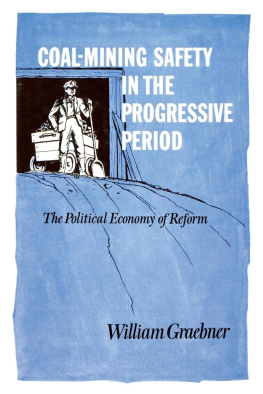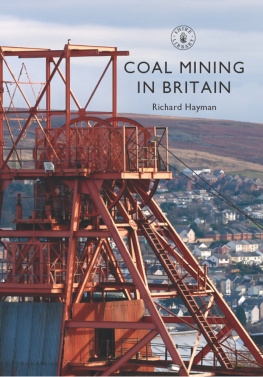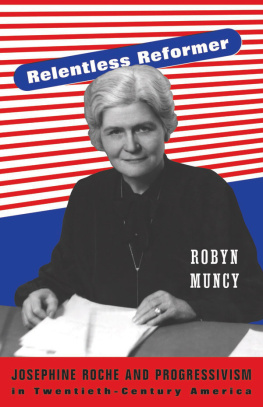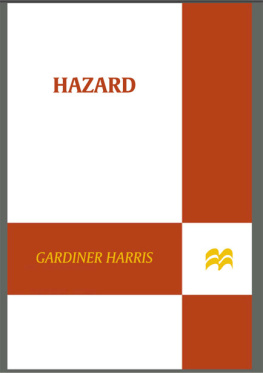Coal-Mining Safety in the Progressive PeriodPUBLISHED FOR
THE ORGANIZATION OF
AMERICAN HISTORIANS
COAL-MINING SAFETY
IN THE
PROGRESSIVE PERIOD
The Political Economy
of Reform
William Graebner
ISBN 978-0-8131-5273-8
Library of Congress Catalog Card Number:7538215
Copyright 1976 by The University Press of Kentucky
A statewide cooperative scholarly publishing agency serving Berea College, Centre College of Kentucky, Eastern Kentucky University, Georgetown College, Kentucky Historical Society, Kentucky State University, Morehead State University, Murray State University, Northern Kentucky State College, Transylvania University, University of Kentucky, University of Louisville, and Western Kentucky University.
Editorial and Sales Offices: Lexington, Kentucky 40506
TO DIANNE
Preface
A FEW YEARS AGO, when I first began to put these materials together, I was convinced that I had come across another Progressive triumph. At the center of that triumph I placed the United States Bureau of Mines, an agency admittedly lacking coercive powers but nonetheless embodying a fresh, national, scientific, ongoing approach to the serious problems of mine safety. There is still some of that emphasis in this book, but I am now less convinced of the propriety of using the bureau, the Progressive periods unique solution to mine accidents and explosions, to exemplify a thoroughly modern institutional response to industrial dislocation. My skepticism derives in part from an examination of mine safety in the states, perhaps the major theater of activity, where the same coal-mine operators who had pressed for a national bureau resisted their state legislatures and inspection services and finally, in their misplaced enthusiasm for uniform state legislation, opposed meaningful national reform. In short, if the coal-mining safety movement may be considered exemplary, then the Progressive period was characterized not by centralization and organization, but by the persistence of decentralization and disorganization. At the heart of this distended society was the Progressive political economy: a hydra of political federalism and competitive capitalism, each a form of decentralization, each feeding on the other, together responsible both for the tragedies in the mines and for the failure to find adequate solutions.
This book is a blend of several approaches to history and varieties of historical writing. I have attempted to place the subject of coal-mining safety in differing perspectives. Although the study focuses on the process of reform in a federal system, I have devoted some attention to technology, bureaucracy, and those miner and operator attitudes which lie outside a traditional political scheme. In general, I have rejected narrative chronological history in favor of organization around subject areas and occupational groups. In the final chapter, I have tried to make my interpretative frameworks as obvious and explicit as possible.
I am grateful to the State University of New York Research Foundation and to the Fredonia Foundation for summer grants in support of this study and to the helpful staffs of research libraries across the country. A special thanks goes to Stanley Brown of the Federal Records Center at Suitland, Maryland, whose cooperation saved me many hours and frustrations. Mary Notaro, who typed the final manuscript, has my appreciation for her precision and tolerance of my errors. The dissertation from which this book has grown was written at the University of Illinois, Urbana, under Clark Spence, and was read by Frederic Jaher and Thomas Krueger, who served on my dissertation committee. I have profited considerably from their observations and suggestions. Robert W. Harbeson of the Department of Economics at Illinois had a clear though indirect impact on this work through his course in competition and monopoly. K. Austin Kerr of Ohio State University read the completed study in full. I am thankful for his expertise in the history of mine safety and for a thoughtful overall critique. Marilee Sargent and Jerry Clore, friends since 1968, have never read this manuscript, but their influence upon it, and upon my life and world view, has been enormous. Dianne Bennett, my wife, has unselfishly given hundreds of hours and her talents in researching, writing, and editing to this project. She has spent her vacations in manuscript collections, her summers near research libraries. I often wonder, had our roles been reversed, if I would have been as willing to donate my time and energies. Her direct contributions to my work have decreased in recent years, and with this I am equally pleased, since it indicates that Dianne has found her own sources of fulfillment and happiness.
Introduction
IN NOVEMBER 1968 an explosion in the safe Number 9 mine of the Consolidation Coal Company at Farmington, West Virginia, killed seventy-eight miners and produced a brief but potent public outcry for new federal safety legislation. The prototype for that scenario of disaster and reform belongs to the Progressive period. It began in December 1907, ten miles from Farmington at Monongah, West Virginia, where 361 miners died in an explosion in the safe Monongah 6 and 8 mines of the Fairmont Coal Company. Monongah, and a number of other major disasters occurring in the same month, put the coal-mining safety problem in proper perspective; it made it a public disgrace. It proved an important stimulus to reform in the states, where a limited coal-mining safety movement had been instrumental in fostering new legislation since 1905. More important, Monongah made national reform likely, for it now became possible for Joseph A. Holmes, chief of the Technologic Branch of the Geological Survey and protagonist in the extended drama to follow, to obtain a hearing for his idea of a national educational and scientific agency to deal with the problem of mine safety. By 1910 a coalition of interests, including miners, inspectors, coal and metal mine operators, conservationists, and bureaucrats, had created the United States Bureau of Mines.
In one sense, the bureau was the cautious first step in the national politics of mine safety; it would be followed in the next few years by a major campaign for uniform state legislation (a form of nationalization) and in the 1940s and 1950s by federal safety standards and inspection. In another sense, the bureau was the end product of rapid changes in the coal industry; the miners at Monongah were victims of economic growth, increasing competition, and changing technology. Production of bituminous coal approximately doubled every ten years beginning in 1840, with increases more gradual (excepting the war years) after 1910. Although the period from 1890 to 1920 was one of steady increase in demand for coal, competition, much of it interregional, also grew in intensity. By 1900 more than twenty-five states mined coal, and Illinois, Pennsylvania, Indiana, Ohio, and West Virginia had emerged as the industrys major producers in the United States. Attempts to satisfy increasing industrial demands for coal created new mine-safety problems and exacerbated old ones. As the mines went deeper, they exposed potentially dangerous concentrations of explosive methane gas; as they became more mechanized (machines cut about 25 percent of the nations coal in 1900 and 42 percent in 1910), coal dust developed as a major health and safety hazard.
The matrix of institutions and processes which the Progressive period brought to bear on mine safety confronted an exceedingly critical situation, but it was one for which there was substantial precedent and preparation. Accidents were reported in the United States as early as 1825, with the first near-disaster in 1856 when four men were buried alive but ultimately rescued. Not until the Avondale disaster of 1869 in the Pennsylvania anthracite territory did coal-mining safety attract sufficient attention to evoke legislative action, although miners had been attempting to secure safety legislation since before the Civil War. A miner, recalling his youth in the coalfields of West Virginia, described the mood surrounding these tragedies:







